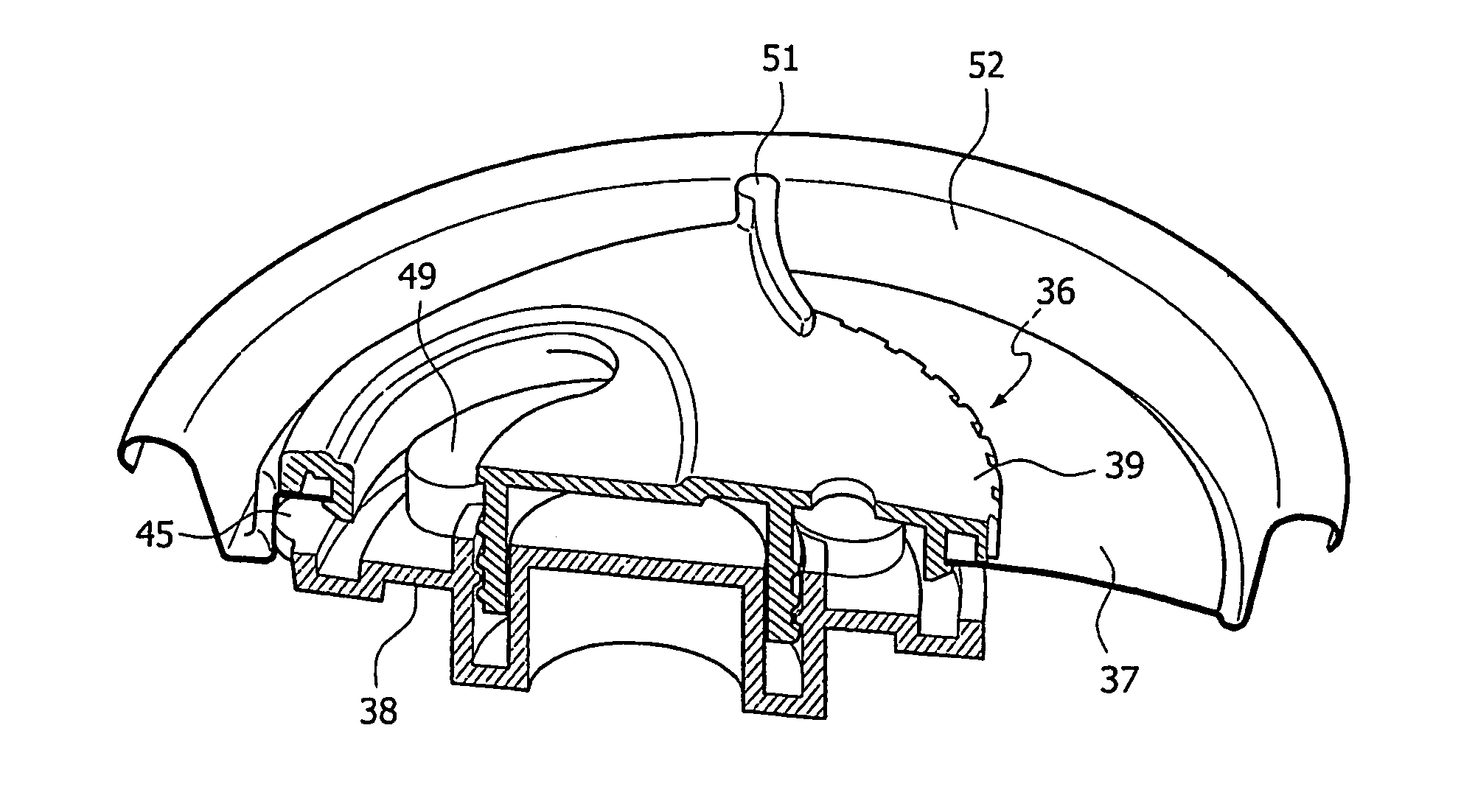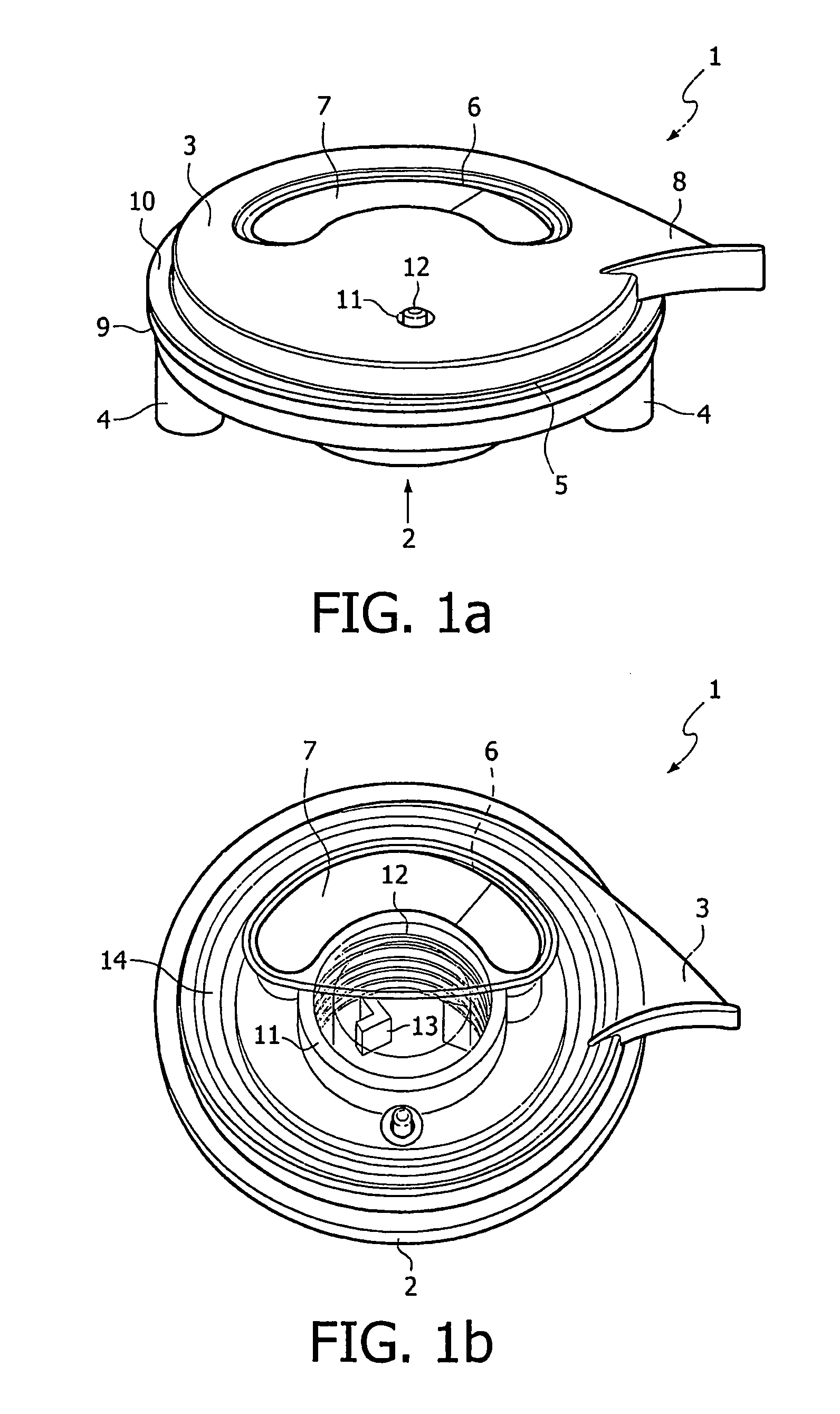[0007]The invention provides for this purpose a device having an operative element adapted to co-act with a sealing element, with the feature that the operating element is provided with
coupling means for
coupling to the food product container, and that the relative orientation of the sealing element and the operating element can be changed such that the operating element can cause the sealing element in the closed position to engage under bias on a wall for substantially medium-tight sealing of the food product container. By causing the sealing element to engage under bias on the wall of the food product container, the food product container is sealed in substantially medium-tight manner. This not only prevents the possibility of the liquid and / or
solid food product leaving the food product container in the closed position of the food product container, but also prevents
gas exchange being able to take place between an
atmosphere surrounding the food product container and an atmosphere prevailing in the food product container. In the case the food product is formed by a
carbonated drink, the
carbon dioxide will remain confined in the food product container in the closed situation, whereby it will also be possible to maintain the
carbon dioxide content in the food product container, which enhances the preservation of taste and the like. Using a device according to the invention it is moreover possible to prevent micro-organisms being able to move, in the closed situation, from outside the food product container to a location inside the food product container. A
constant composition of the food product can therefore be guaranteed with the device according to the invention in closed position, wherein the food product can also be conserved in relatively hygienic manner in the closed food product container. In the opened situation of the sealing element, the sealing element is generally situated substantially at a distance from the wall, whereby removal of food product along the sealing element and via the wall opening can take place freely and preferably unimpeded. After sufficient removal of the food product, the sealing element can be displaced once again to the closed position, wherein a bias will be exerted directly or indirectly on the wall in order to realize the medium-tight sealing of the food product container. The bias exerted on the wall by the sealing element can be adjusted in discrete or continuous manner by means of the operating element for a user.
[0008]The sealing element and the operating element can be located substantially on one side relative to the wall, but the sealing element and the operating element are preferably adapted to mutually enclose a part of the wall of the food product container. The operating element generally has to be readily accessible to the user and will usually be positioned substantially on an outer side of the wall. The sealing element is preferably located at least substantially inside the food product container. In this manner it is possible to prevent, or at least counter, the sealing part—usually a sealing edge—of the sealing element becoming dirty relatively easily, which is often at the expense of the reliability of the medium-tight sealing.
[0012]In another preferred embodiment the operating element is provided with at least one receiving space for a pin projecting from the wall. The pin preferably projects in the direction of a space enclosed by the food product container, so as to minimize the number of components protruding in the direction of the user. The pin is preferably formed by a cylindrical body, but can optionally also be designed in other manner. The mutual co-action of the pin and the receiving space prevents rotation of the sealing element. The sealing element is however displaceable along the pin, whereby translation of the sealing element relative to the wall and the operating element, for instance after rotation of the operating element, remains possible. The pin can be formed by a bent and / or folded part of the wall, but may also form part of an intermediate element, for instance a stationary intermediate ring, placed separately between the sealing element and the operating element. The intermediate ring is then preferably connected fixedly to the wall, wherein the pin preferably projects via the wall opening in the direction of the sealing element. The
advantage of the intermediate ring is that the existing structure of a conventional food product container need not be changed in order to apply the pin in order to prevent rotation of the sealing element. It is then possible to suffice with an intermediate ring or other type of intermediate element separately manufactured and arranged at a later stage. In order to further stabilize prevention of rotation of the sealing element, a plurality of (spaced-apart) projecting pins may be applied.
[0013]The operating element is preferably provided with a projecting engaging member for a user. The projecting engaging member generally facilitates opening respectively closing of the food product container. The engaging member can for instance be formed by a fin-like member. In addition to serving as
handle, the projecting member can also serve to bound the maximum rotation of the operating element, since in particular food
product containers, such as drink cans, the wall opening is arranged asymmetrically in the wall, wherein after a determined rotation the projecting engaging member will engage on a seam-folded part of the wall, whereby further rotation of the operating element can be prevented. An outer edge of the operating element can also be given a profiled form, whereby this outer edge can effectively also function as engaging member for the user.
[0014]The operating element is preferably provided with a passage opening for the food product held in the food product container. From a hygienic viewpoint the passage opening can more preferably be sealed by a screening element forming part of the sealing element and projecting in the direction of the operating element. This applies particularly in the case
liquid food products, in particular drinks, are held in the food product container. The passage opening bounded by the operating element will then generally result in an improved
sensation the user when the drink is consumed directly from the food product container, since the operating element—generally manufactured from plastic—will provide a better
sensation than the generally sharp
peripheral edge of the wall opening. Furthermore, injuries to the user resulting from cuts from the
peripheral edge can thus be prevented, or at least countered.
[0015]The operating element is preferably provided with a venting opening. Particularly in the case of
liquid food products, usually drinks, a venting opening will be advantageous, particularly during removal of the drink from the drink container. Gurgling removal of drink can thus be prevented, or at least countered.
 Login to View More
Login to View More  Login to View More
Login to View More 


